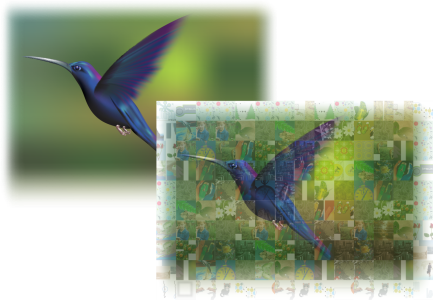
| • | To create a mosaic from bitmap or vector objects |
| • | To choose settings |
The PhotoCocktail effect lets you turn your photos and vector art into unique mosaics composed of selected images.
Turning artwork into a mosaic composed of images (Elements from artwork by Ariel Garaza Díaz)
| To create a mosaic from bitmap or vector objects |
|
| 1 . | Select the reference image (bitmap, vector object, or group of objects) that you want to recreate as a mosaic. |
| 2 . | Click Effects |
| 3 . | In the PhotoCocktail docker, click Browse in the Library area, and browse to the image library, the folder that contains the images to be used as tiles. Click Select folder. |
| PhotoCocktail indexes the images and shows how many of them can be used as tiles. The Path control shows the location of the selected image library. |
| 4 . | Choose any settings you want. |
| 5 . | Click Apply. |
| To choose settings |
|
Additional controls are available in the PhotoCocktail docker to help you customize the effect.
Keep original: Enable this check box if you want to keep the reference image or objects after applying the effect. Disable the check box to delete the reference image and leave only the mosaic.
Columns: This box lets you specify how many columns of tiles to include in the mosaic. The bigger the number, the more detail in the mosaic.
Rows: Shows the number of rows to be included in the mosaic. The number is automatically calculated based on the value in the Columns box.
Left: Mosaic with low grid density (fewer columns and rows); Right: Mosaic with high grid density
Blending: This box lets you specify to what extent to blend the reference colors with the tile colors. Higher values increase the likeness of the mosaic to the reference image.
Left: No blending; Right: Large amount of blending applied
You can use duplicate tiles in the final mosaic.
Allow duplicates: Enable this check box to repeat tiles in the final mosaic. You can specify the minimum number of tiles that surround duplicate tiles in the Min. distance box.
Output controls let you define the composition and quality of the final mosaic.
Composition: This list box lets you choose one of the following options:
| • | Single bitmap renders the mosaic as a single rasterized image, with the blending effect incorporated in the image. |
| • | Bitmap stack produces a single rasterized image with the blending effect layered on top as a single object. |
| • | Bitmap array creates a group of bitmap tiles, with the blending effect layered on top as a single object. |
Edges: This list box lets you choose a method for treating incomplete tiles around the edges. For example, incomplete tiles around the edges can be removed from the final mosaic, or the output can be stretched to match the reference image. Stretching the output results in mosaic tiles that are rectangular rather than square.
Priority: This list box lets you choose one of the following methods for adjusting the output quality:
| • | The Match document DPI method automatically generates a mosaic that has the same DPI (dots per inch) as the active document. |
| • | The Custom DPI method lets you specify the dpi of the final mosaic in the DPI box. |
| • | The Custom tile dimensions method lets you specify the width of each tile in the first Tile box. The tile height is automatically calculated. Tile dimensions are shown in pixels. |
| • | The Custom output dimensions method lets you specify the width of the final mosaic in the first Artwork box. The height is automatically calculated. The maximum dimensions of a mosaic are 15,000 x 15,000 pixels. |
The mosaic DPI is influenced by the grid density and the dimensions of the mosaic.
![]()
Not all suite components documented in this Help are available in our Trial, Academic, and OEM versions. Unavailable components may include Corel applications, product features, third-party utilities, and extra content files.
Copyright 2018 Corel Corporation. All rights reserved.